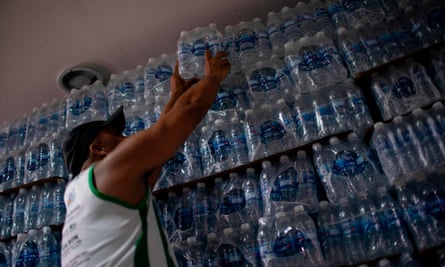Just weeks before hosting its world famous carnival – and with summer temperatures soaring past 40C (104F) – Rio de Janeiro is on edge as residents across the city complain of murky and foul-smelling tap water.
Scores of neighbourhoods in the city of 6.7 million people, as well as six nearby towns, have been affected by the crisis, which has dragged on for nearly two weeks.
Social media feeds have been flooded with photos and videos of clay-coloured water, while supplies of bottled water have run low.
The city’s publicly-owned water company has said the strange taste was caused by an organic compound called geosmin (which is found naturally in soil), and insisted the water was safe to drink.
But residents have complained of falling sick after drinking the water, and environmentalists blamed the crisis on polluted rivers, a lack of basic sanitation and decades of mismanagement.

Emily dos Santos, 20, who works for an arts NGO, fell sick after drinking filtered tap water. “I had a fever and diarrhoea; I vomited a lot for three days,” she said. “The doctor said it was bacteria in the water – and that lots of other people had come in with the same symptoms.”
Cleaning up the city’s water and sewage was supposed to be part of its legacy for hosting the 2016 Olympics, but never happened.
Cellphone technician Kamilla dos Santos, 28, who lives in Rio’s north zone, was sick for five days. “You can’t drink the water; it tastes awful – like clay – and it has a terrible smell,” she said.
Rio state’s governor, Wilson Witzel, tweeted that the situation was “inadmissible” and said he has ordered demanded a “rigorous investigation” into water quality and water company management.
The water company CEDAE has sacked the manager of its Guandu treatment station which treats most of Rio’s water and said supplies will start returning to normal by next week.
“Our results show the presence of geosmin, in sufficient quantity to change the taste,” Sérgio Marques, quality control manager, told reporters on Wednesday.
José Godoy, a professor of chemistry and water specialist at Rio’s Pontifical Catholic University said summer rains could have washed soil into rivers, causing an increase of geosmin.
But the compound is also produced by the algae that thrive in polluted waters, said Mario Moscatelli, a biologist and environmental campaigner who has studied the city’s filthy waterways for decades. And the three rivers that supply the Guandu treatment centre, he said, are essentially “sewage gullies”.
The crisis was “the sum of all the mistakes made in the last 50 years”, he said, noting that favelas lacking basic sanitation have grown up on rivers and blaming “uncontrolled urban expansion and lack of investment in basic sanitation”.
Last July, Rio prosecutors signed an agreement with CEDAE to finish Olympic sanitation works which were frozen when the state declared a “financial emergency” weeks before the games began. Some projects have been completed but major works are expected to take four more years.
